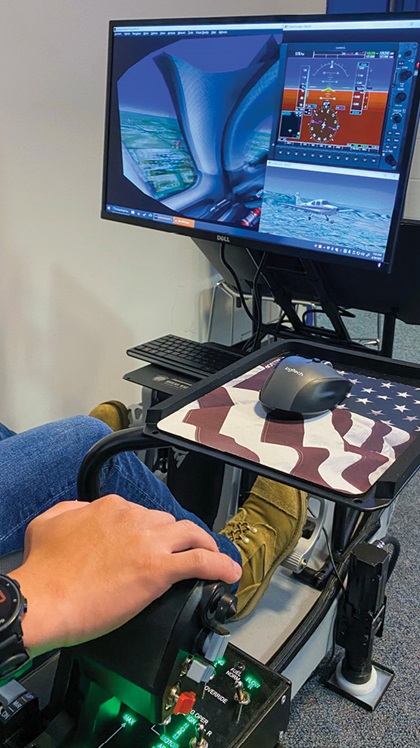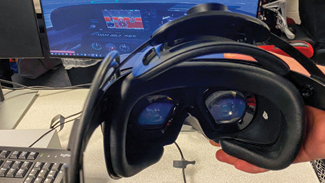Pilot Products: Game on
Virtual reality comes to real flight training
 The cadets’ ability to master the principles of flight taught here will help determine their fitness for military pilot training, and that will shape their careers as U.S. Air Force officers. The VR technology they’re using also has the potential to improve civilian flight training while sharply reducing costs and making the entire process more enjoyable.
The cadets’ ability to master the principles of flight taught here will help determine their fitness for military pilot training, and that will shape their careers as U.S. Air Force officers. The VR technology they’re using also has the potential to improve civilian flight training while sharply reducing costs and making the entire process more enjoyable.
“The wind’s behind you now so you know your ground speed’s increasing,” a classroom instructor tells a cadet at one of the sims. “That means your next turn has got to be steeper to maintain the proper ground track.”
The cadets are intently focused on their seventh online lesson on the VR simulators, and the tasks are centered on flying a simulated Cirrus SR20 around a precise rectangular ground track while compensating for a 20-knot crosswind. Throughout the exercise they are told to maintain 90 knots and 5,500 feet.
An automated voice in their headset tells them whenever they stray, and engine and wind noise rise and fall as they adjust power settings. Red and white ground markers show the track they’re meant to follow, and in some lessons, there are circular targets to fly through along the way.
The cadet I’m observing has never flown an actual aircraft before, but he adjusts the airplane’s crab angle to precisely follow the desired ground track and adds power in the turns to maintain a constant airspeed. At the end of the 8-minute lesson, however, the computer gives him a failing grade for straying from the target airspeed and altitude. He immediately resumes the exercise and says he’ll stick with it “as long as it takes” to master the skills.
Each $14,000 simulator is built from commercially available hardware assembled and maintained by True Course Simulations, an Arizona company that also creates the educational content for each flight scenario. The simulators have limited motion, and VR helmets with audio provide an immersive experience.
I tried out one of the simulators and flew several scenarios, including an SR20 crosswind landing, and was amazed at the fidelity, realism, and the high-impact graphics the technology offers.
When the automated instructor voice refers to the aiming point on the runway, for example, the white fixed-distance markers flash brightly so there can be no doubt about the target. When the instructor says to follow a constant glidepath, a green line appears like a laser beam from the nose of the airplane to the aiming point. In the landing flare, the instructor says to “look here” to judge height above the runway, and vertical arrows appear to mark the spot.
When a student approaches a stall, the simulator buffets and shakes so conspicuously it can’t be ignored.
“Max, relax, and roll,” the classroom instructor advises, repeating the stall-recovery procedure U.S. Air Force students are sure to hear in pilot training. “That was just right.”
The ability of private firms like True Course to produce and share aviation education and flight safety content promises to keep pilots engaged without consuming avgas. VR simulation doesn’t yet count for FAA currency requirements, but that’s likely to change as the technology becomes more widespread and mature. And just because it’s not loggable doesn’t mean it’s not valuable.
True Course founder and lead instructor Ray Bédard, a former Royal Canadian Air Force pilot and an aviation educator for more than 20 years, said the immersive, intense experience VR provides can instill aviation skills deeply and quickly, and that allows flight students to make faster progress at less total cost.
“Students quit flying for two reasons,” he said. “They’re not having fun, or they run out of money.” In both areas, VR has the potential to make actual reality better.
 Bookshelf
Bookshelf
GIRL POWER
Women of Adventure: Being Brave in a Big World
Garmin International Inc. recently announced a new offering: children’s books. Garmin has published Women of Adventure: Being Brave in a Big World, which features six stories from the Garmin Women of Adventure YouTube series highlighting “strong, fearless, curious, selfless, and brave women who have overcome great obstacles, accomplished amazing feats and simply aren’t bound by convention.” The book is written and illustrated by Garmin associates and explores each woman and the unique way she touched on the “science behind her sport or passion, to encourage readers to explore the world and find ways to be brave every day.” —Jennifer Non
PRICE: $14.99
CONTACT: garmin.com
A YOUNG AVIATRIX
Hardly Easy
Kimberley Jochl, pilot and author of The Aviatrix: Fly Like a Girl and Fly Baby: The Story of an American Girl, brings us a novel for young adults that aims to inspire and motivate a younger generation of future pilots. The book shares the story of a young aspiring aviatrix Charlotte “Charlie” Henson, who at age 12 is taken for her first flight by her uncle on her birthday. From that day forward, Charlie aspires to get back in the sky on her own and devotes her future to becoming a U.S. Navy pilot. —Jennifer Non
PRICE: $13.25
CONTACT: kimberleyjochl.com

 Like other simulators, the VR versions by True Course are harder to fly than actual airplanes. They don’t exactly replicate the sensations of the landing flare or touchdown, and ground handling is far more sensitive than in a real Cirrus. These VR sims produce highly realistic views of the cockpit and instrument panel, but you can’t reach out and turn knobs or push buttons because it can’t sense hand position. True Course founder Ray Bédard says VR simulation is meant to teach and reinforce procedures, and it does that extremely well. It’s easy to imagine VR sims in high school and collegiate aviation education programs, flight schools, flying clubs, and homes. “Simulation isn’t meant to replace real airplanes,” he said. “Use simulators and airplanes together for the things each of them is good at.” —DH
Like other simulators, the VR versions by True Course are harder to fly than actual airplanes. They don’t exactly replicate the sensations of the landing flare or touchdown, and ground handling is far more sensitive than in a real Cirrus. These VR sims produce highly realistic views of the cockpit and instrument panel, but you can’t reach out and turn knobs or push buttons because it can’t sense hand position. True Course founder Ray Bédard says VR simulation is meant to teach and reinforce procedures, and it does that extremely well. It’s easy to imagine VR sims in high school and collegiate aviation education programs, flight schools, flying clubs, and homes. “Simulation isn’t meant to replace real airplanes,” he said. “Use simulators and airplanes together for the things each of them is good at.” —DH

